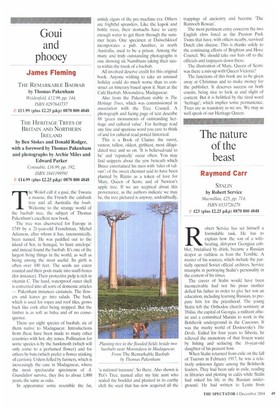Goui and phooey
James Fleming
THE REMARKABLE BAOBAB by Thomas Pakenham Weidenfeld, £12.99, pp. 144, ISBN 0297843737 it £11.99 (plus £2.25 p&p) 0870 800 4848 THE HERITAGE TREES OF BRITAIN AND NORTHERN IRELAND by Ben Stokes and Donald Rodger, with a foreword by Thomas Pakenham and photographs by Archie Miles and Edward Parker Constable, £16.99, pp. 192, ISBN 1841199591 £14.99 (plus £2.25 p&p) 0870 800 4848 The Wolof call it a gotii, the Tswana a moana, the French the calabash tree and all Australia the boab. Welcome to the strange world of the baobab tree, the subject of Thomas Pakenh am's excellent new book.
The tree was discovered for Europe in 1749 by a 21-year-old Frenchman, Michel Adanson, after whom it has, taxonomically, been named. He was paddled out to the island of Sor, in Senegal, 'to hunt antelope' and instead found the baobab. It's one of the largest living things in the world, as well as being among the most useful. Its girth is often over 100 feet. The seeds are eaten roasted and their pods made into snuff-boxes (for instance). Their protective pulp is rich in vitamin C. The hard, waterproof outer shell is converted into all sorts of domestic articles — Pakenham instances castanets. The flowers and leaves go into salads. The hark, which is used for ropes and roof tiles, grows back like cork after being stripped. But the timber is as soft as balsa and of no consequence.
There are eight species of baobab, six of them native to Madagascar. Introductions from these have been made to many other countries with hot, dry zones. Pollination for some species is by the hawkmoth (which will only come to a perfumed flower) and for others by bats (which prefer a flower stinking of carrion). Unless felled by farmers, which is increasingly the case in Madagascar, where the most spectacular specimens of A. Grandidieri survive, they live to about 1,000 years, the same as oaks.
In appearance some resemble the fat, untidy cigars of the pre-machine era. Others are frightful sprawlers. Like the kapok and bottle trees, their stomachs have to cam enough water to get them through the summer heats. One specimen at Duiwelskloof incorporates a pub. Another, in north Australia, used to he a prison. Among the many and truly outstanding photographs is one showing six Namibians taking their siesta within the trunk of a baobab.
All involved deserve credit for this original book. Anyone wishing to take an unusual holiday could do much worse than to construct an itinerary based upon it. Start at the Cafe Baobab, Morondava, Madagascar.
Also from the Pakenham stable is The Heritage Trees, which was commissioned in association with the Tree Council. A photograph and facing page of text describe 88 'green monuments of outstanding heritage and cultural value'. For heritage read any fine and spurious word you care to think of and for cultural read potted historical.
This is a Book of Claims: the rarest, vastest, tallest, oldest, girthiest, most dilapidated tree and so on. 'It is believed/said to be' and 'reputedly occur often. You may find snippets about the yew beneath which Bruce entertained his men with 'tales of valour': of the sweet chestnut said to have been planted by Rizzi° as a token of love for Mary, Queen of Scots; and of Newton's apple tree. If we are sceptical about this provenance, as the authors indicate we may he, the tree pictured is artr,vay, undoubtedly,
'a national treasure'. So there. Also shown is Pet's Tree, named after my late aunt who scaled the boulder and planted in its earthy cleft the seed that has now acquired all the trappings of ancientry and become 'The Rannoch Rowan'.
The most pertinent entry concerns the two English elms listed as the Preston Park Twins that have, with others nearby, survived Dutch elm disease. This is thanks solely to the continuing efforts of Brighton and Hove Council. We should take our hats off to the officials and taxpayers down there.
The illustration of Mary, Queen of Scots: was there a mix-up with Queen Victoria?
The functions of this book are to be given away at Christmas and to make money for the publisher. It deserves success on both counts, being nice to look at and slight of content. But it is belittled by the tired word 'heritage', which implies some permanence. Trees are as transitory as we are. We may as well speak of our Heritage Queen.


















































































 Previous page
Previous page